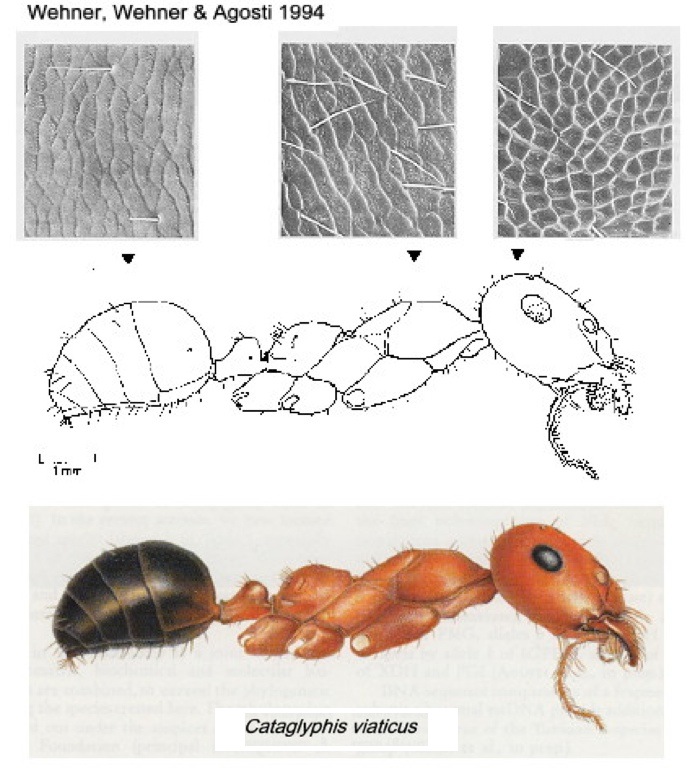Cataglyphis viaticus (Fabricius)
 Bolton (1995) had - Type
location Spain (Formica viatica, Fabricius, 1787: 308,
worker; Mayr, 1861, queen & male) collector Vahl - no images on Antweb (January 2019)
but image from ZMCU - see below Bolton (1995) had - Type
location Spain (Formica viatica, Fabricius, 1787: 308,
worker; Mayr, 1861, queen & male) collector Vahl - no images on Antweb (January 2019)
but image from ZMCU - see below
junior synonyms
europaea
(Formica cephalotes ssp europaea,
Christ, 1791: 511, illustrated, worker; synonymy Emery, 1892b: 161)
from "Europe" - no images on Antweb (January 2019)
bugnioni
(Myrmecocystus viaticus F. r. adenensis Forel v. Bugnioni n. var., Forel, 1908a: 16;
Santschi, 1929b: 41, worker) from Egypt, Suez - new
placement here - see below.
new here
basalis (Cataglyphis
bicolor var. basalis
n. var., Santschi, 1929b: 42, all forms)
from Algeria - see http://www.antweb.org/specimenImages.do?code=casent0912181
pubens (Cataglyphis
bicolor var. pubens
n. var., Santschi, 1929b: 43, all forms) from Morocco - see http://www.antweb.org/specimenImages.do?code=casent0912185
rufiventris (Myrmecocystus
(Cataglyphis) viaticus
F. subsp. orientalis Forel v.
rufiventris n.
var., Forel, 1911d: 353; as M.
bicolor var. orientalis
in Emery, 1925b: 265,
worker) from Greece, Corfu at edge of sea - see below.
all forms known.
Fabricius' (1787) description is at -  . Christ's (1791) description of europaea
is at - . Christ's (1791) description of europaea
is at -  . Olivier (1792) had the description - . Olivier (1792) had the description -  . Mayr (1855: 381) had the description (as Monocombus
viaticus) - . Mayr (1855: 381) had the description (as Monocombus
viaticus) -  . Emery (1906b) had the
description - . Emery (1906b) had the
description -  . Forel's (1908a)
description of bugnioni
is at . Forel's (1908a)
description of bugnioni
is at  . .
Note from the description and illustration it is clear
that
the form listed in Bolton (1995: 137) as subspecies tonsilis
(Cataglyphis (Monocombus) viatica
F. st. mauritanica Em. v. tonsilis n. var., Santschi, 1929b:
32; Cataglyphis (Monocombus) viaticus
For. v. tonsilis Sants.,
Santschi, 1936a: 209, all forms) from Morocco, is a subspecies
or junior synonym of Cataglyphis mauritanicus.
|
 Fabricius
stated specimens from the Iberian Peninsula
were ferruginous with a black gaster. Mayr (1855) appears to have
confused the identities as he gave the colour as blood red with a dark
gaster. He listed it as found across much of southern Europe and gave Formica
megalocola Foerster as a synonym. F. megalocola now is
recognised as a junior synonym of Cataglyphis
bicolor. Fabricius
stated specimens from the Iberian Peninsula
were ferruginous with a black gaster. Mayr (1855) appears to have
confused the identities as he gave the colour as blood red with a dark
gaster. He listed it as found across much of southern Europe and gave Formica
megalocola Foerster as a synonym. F. megalocola now is
recognised as a junior synonym of Cataglyphis
bicolor.
The drawings from Emery (1906d) are accurate for C.
mauritanicus but not for viaticus which has a
domed petiole, see the type below. Presumably taking Fig 22 as
accurate, Santschi (1929b: 29) declared the subgenus Monomombus had as its type Formica viaticus Fabricius, with
the petiole being squamiform. Taking out viaticus the type would be
the Formica cursor of
Fonscolombe 1846 (see https://www.antweb.org/specimenImages.do?name=casent0913667).
Christ, J. L. 1791. Naturgeschichte, Classification und
Nomenklatur der Insecten von Bienen, Wespen, und Ameisengeschlecht; als
der fuenften Klass fuenften Ordnung des Linneischen Natur-Systems von
den Insecten Hymenoptera. Hermann, Frankfurt am Main. 535 pp
One of the species studied by Dahbi, Hefetz & Lenoir
(2008) - http://irbi.univ-tours.fr//UIEIS/Publis%20AL/Dahbi2008-BSE.pdf
|
 Agosti (1990a),
however, separated tonsilis as a
variety of mauritanicus in the altisquamis-group (see
above). Some clarification comes from
Wehner, Wehner & Agosti (1994), who provided the illustration
(right). Agosti (1990a),
however, separated tonsilis as a
variety of mauritanicus in the altisquamis-group (see
above). Some clarification comes from
Wehner, Wehner & Agosti (1994), who provided the illustration
(right).
I have separated off Cataglyphis
desertorum, which appears to be clearly distinct, with a
nodiform petiole, and not least from the geographical separation. Thus,
the true distribution of viaticus appears to be western North
Africa and the Iberian Peninsula
|